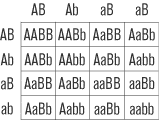Lesson: Chapter - 7
Explanations of Mendelian and Molecular Genetics :Review Questions
1.E
In meiosis, sister chromatids separate during anaphase II. During prophase I, sister chromatids are linked at their centromeres. At metaphase I, each pair of sister chromatids lines up in the middle of the cell together with its homologous pair of sister chromatids, and only homologous chromosomes separate during anaphase I. During metaphase II, each pair of sister chromatids again lines up along the metaphase plate, but they do not separate until anaphase II.
2. D
Meiosis divides a single diploid cell into four haploid cells. In the case of oogenesis, only one of those daughter cells goes on to become a fully developed egg cell, leaving three “polar bodies” to disintegrate; the original product, however, is still four cells.
3. B
The first (F1) generation of offspring from a hybrid cross will all look the same. A hybrid cross involves the mating of a homozygous dominant (RR) individual with a homozygous recessive (rr) individual, so the parents do not look the same. In the F1 generation, all offspring will have genotype Rr and will all show the dominant trait. Other generations will contain some individuals with the dominant phenotype (RR or Rr) and some with the recessive phenotype (rr) and so will not all look the same.
4. D
Approximately 75% of the F2 generation will exhibit the dominant phenotype. Genotypically, there will be three types of offspring: 25% homozygous dominant, 50% heterozygous dominant, and 25% homozygous recessive. Only the homozygous recessive will show the recessive phenotype—therefore, a total of 75% will have the dominant phenotype.
5. E
Because these genes are on separate chromosomes and therefore act independently, we can use a Punnett square to work out the results of this dihybrid cross.

For every sixteen offspring in the F2 generation, approximately nine will exhibit the dominant phenotype of both genes (genotype AABB, AABb, AaBB, or AaBb), three will be dominant on gene A only (AAbb or Aabb); three will be dominant on gene B only (aaBB or aaBb), and one will show a recessive phenotype on both genes (aabb). The result is a phenotype ratio of 9:3:3:1.
6. D
In order to determine the genotype of a dominant-appearing individual, the scientist would have to perform a test cross (also known as a back cross) using a fully recessive individual. In this case, that would be a short and green plant.
7.D
Given the fact that the expected 3:1 dominant-to-recessive phenotype showed up on the same F2 offspring plants, it looks like these genes are linked and were not acting independently of each other. From this information, you can predict that the two genes controlling these traits are on the same chromosome. Since crossing-over limits the effects of linkage—and crossing-over occurs more often when two genes are far apart on the same chromosome— you can further determine that the two genes must be near each other on the chromosome.
8. of a person who has an autosomal recessive disease must be homozygous recessive. Therefore, if two parents have the disease, 100% (not 50 or 75%) of their children should get the disease, since neither parent has dominant alleles to contribute.
9.C
50% of the coupC
The genotypele’s daughters would be expected to have hemophilia, an X-linked recessive disease. Using a Punnett square to do the cross of the father (X hemophilia/Y) and the mother (X normal/X hemophilia), you should find that half of the female children will be homozygous for the X hemophilia gene and have the disease, while half will be heterozygous and be carriers of the disease.

10.C
Although the father is color blind, the gene for this condition is located on the X chromosome. The father could not have given his son the condition, because he only contributes a Y chromosome to his son; therefore, the gene that causes the disease must have been inherited from the mother.
Next to display next topic in the chapter.
Practice Questions
Test Prep Lessons With Video Lessons and Explained MCQ
Large number of solved practice MCQ with explanations. Video Lessons and 10 Fully explained Grand/Full Tests.